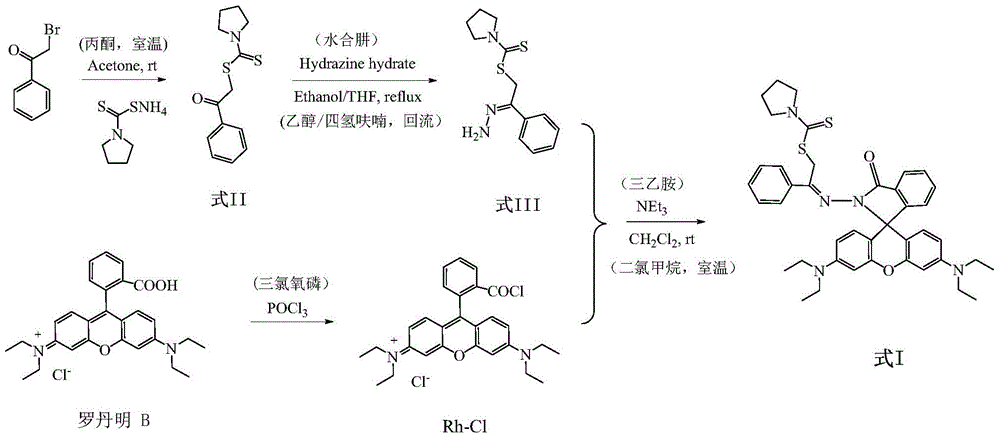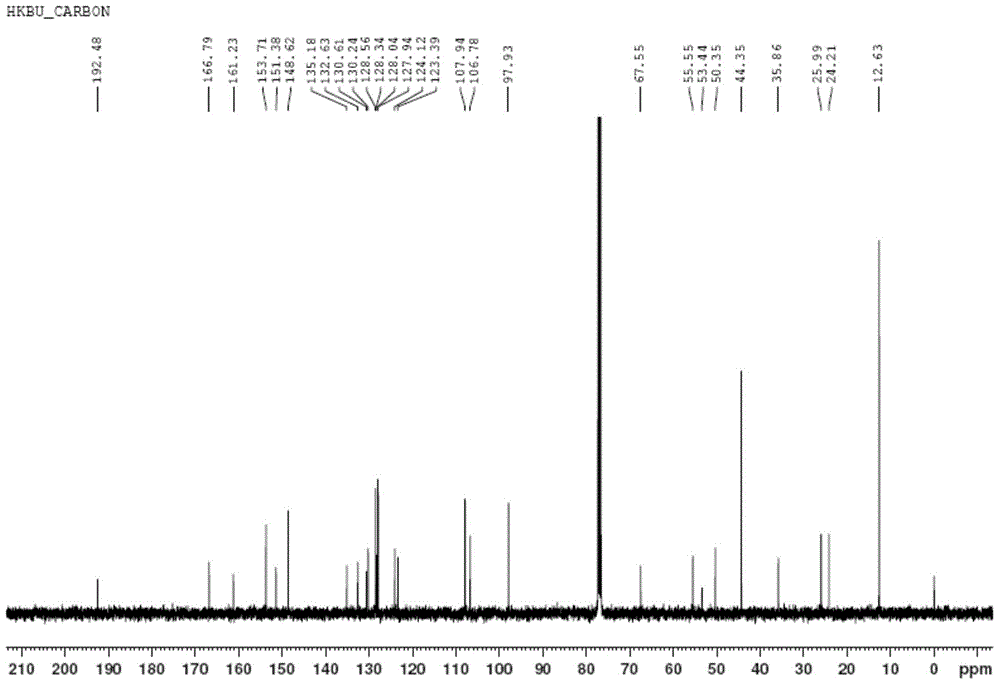Rhodamin B double-sulfur fluorescence probe for detecting aqueous mediums and intracellular mercury ions, preparation and application thereof
A fluorescent probe, a technology for detecting water, applied in fluorescence/phosphorescence, luminescent materials, chemical instruments and methods, etc., can solve the problems of unsatisfactory selectivity, sensitivity and biocompatibility of fluorescent probes, and achieve good detection. Sensitivity, good cell permeability effect
- Summary
- Abstract
- Description
- Claims
- Application Information
AI Technical Summary
Problems solved by technology
Method used
Image
Examples
Embodiment 1
[0035] (1) The synthetic steps of a fluorescent probe for detecting mercury ions in aqueous media and cells provided by the present invention are as follows: figure 1 As shown, the details are as follows: at room temperature, 1.99g (1.0mmol) 2-bromoacetophenone and 1.64g (1.0mmol) 1-pyrrolidine ammonium dithiocarboxylate were dissolved in 30mL of acetone, and stirred at room temperature to The termination of the reaction was detected by TLC, and the solvent was evaporated to obtain a yellow solid, which was recrystallized from absolute ethanol to obtain a white disulfide intermediate-I with a yield of 75%;
[0036] Characterization data: 1 HNMR (400M, CDCl 3 ):δ=1.96(m,2H),2.08(m,2H),3.74(t,J=7.2Hz,2H),3.91(t,J=7.2Hz,2H),4.92(s,2H),7.48 (t, J=7.6Hz, 2H), 7.81(t, J=6.4Hz, 1H), 8.08(m, 2H); 13 CNMR (101M, CDCl 3 ): δ=24.39, 26.18, 44.51, 50.82, 55.50, 128.59, 128.71, 136.08, 191.00, 193.44; FAB-MS: m / z=265.
[0037] The structural formula is as shown in formula II:
[0038...
Embodiment 2
[0047] (1) The synthetic steps of a fluorescent probe for detecting mercury ions in aqueous media and cells provided by the present invention are as follows: figure 1 Shown, specifically as follows: at room temperature, 1.99g (1.0mmol) 2-bromoacetophenone and 1.97g (1.2mmol) 1-pyrrolidine ammonium dithiocarboxylate were dissolved in 30mL acetone, stirred at room temperature to The termination of the reaction was detected by TLC, and the solvent was evaporated to obtain a yellow solid, which was recrystallized from absolute ethanol to obtain a white disulfide intermediate-I with a yield of 77%;
[0048] (2) Under nitrogen protection, 1.00 g of the disulfide intermediate obtained in step (1) was dissolved in a mixed solvent of 20 mL of tetrahydrofuran and absolute ethanol (volume ratio 1:1), and then 1.60 mL (disulfide intermediate) was added. 8 times the molar equivalent of body-I) hydrazine hydrate, the mixed solution was refluxed until the reaction was terminated by TLC metho...
Embodiment 3
[0051] (1) The synthetic steps of a fluorescent probe for detecting mercury ions in aqueous media and cells provided by the present invention are as follows: figure 1 As shown, the details are as follows: at room temperature, 1.99g (1.0mmol) 2-bromoacetophenone and 2.50g (1.5mmol) 1-pyrrolidine ammonium dithiocarboxylate were dissolved in 30mL acetone, and stirred at room temperature until The termination of the reaction was detected by TLC, and the solvent was evaporated to obtain a yellow solid, which was recrystallized from absolute ethanol to obtain a white disulfide intermediate-I with a yield of 78%;
[0052] (2) Under the protection of nitrogen, 1.00 g of the disulfide intermediate obtained in step (1) was dissolved in a mixed solvent of 20 mL of tetrahydrofuran and absolute ethanol (volume ratio 1:1), and then 2.00 mL (disulfide intermediate 10 times the molar equivalent of body-I) hydrazine hydrate, the mixed solution was refluxed until the reaction was terminated by ...
PUM
 Login to View More
Login to View More Abstract
Description
Claims
Application Information
 Login to View More
Login to View More - R&D
- Intellectual Property
- Life Sciences
- Materials
- Tech Scout
- Unparalleled Data Quality
- Higher Quality Content
- 60% Fewer Hallucinations
Browse by: Latest US Patents, China's latest patents, Technical Efficacy Thesaurus, Application Domain, Technology Topic, Popular Technical Reports.
© 2025 PatSnap. All rights reserved.Legal|Privacy policy|Modern Slavery Act Transparency Statement|Sitemap|About US| Contact US: help@patsnap.com



